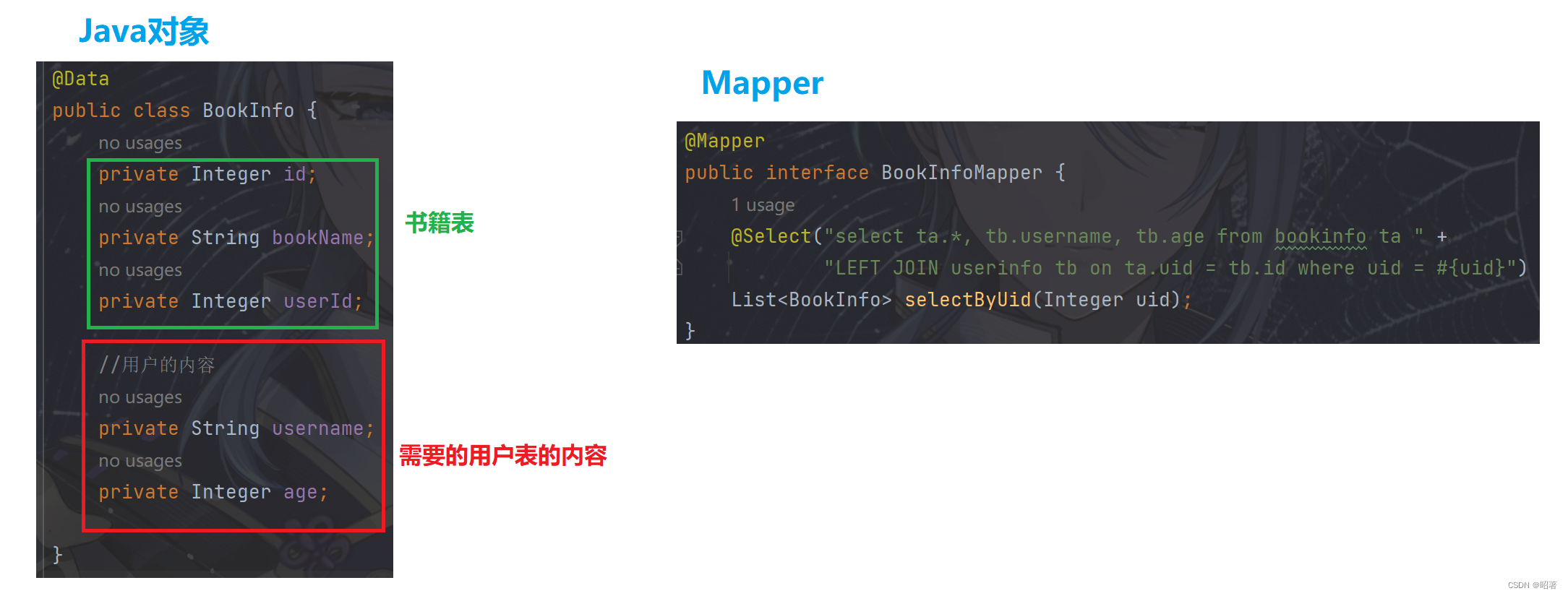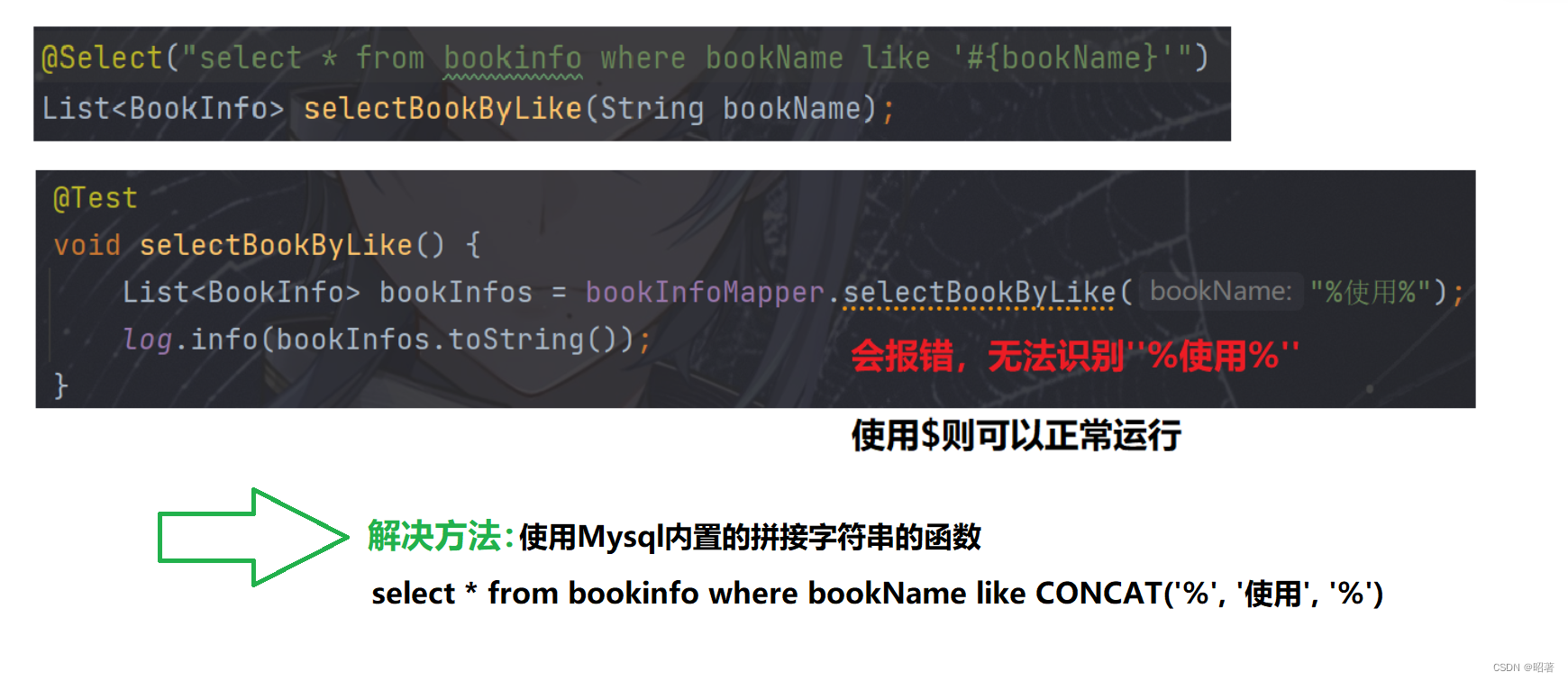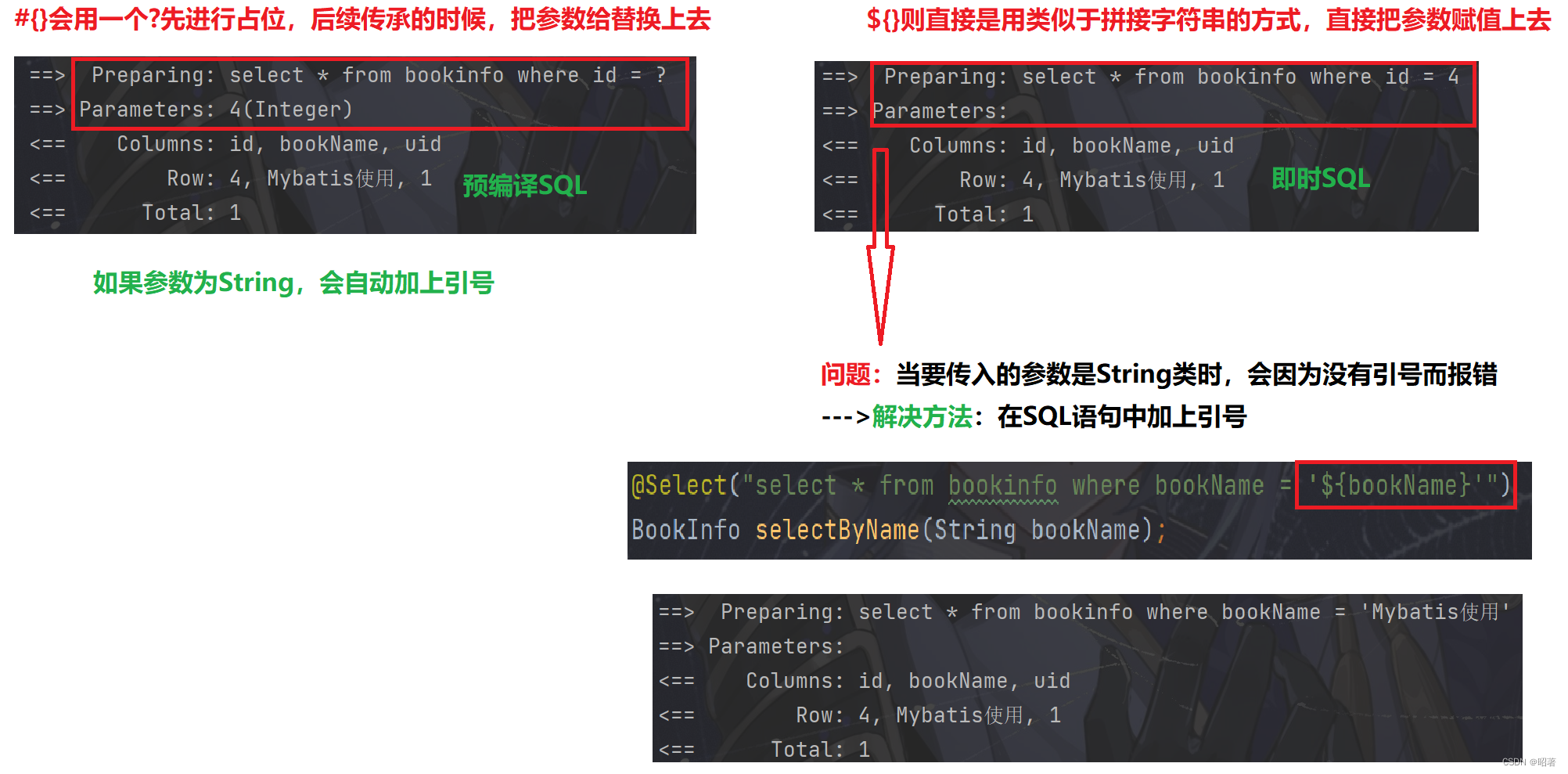文章目录
- 一、用注解编写
- 1.1 增
- 普通增加
- 获取自增ID
- 1.2 删和改
- 1.3 查
- 单表查询
- 多表查询
- 二、用xml编写
- 2.1 使用xml的流程
- 2.2 增
- 普通增加
- 获取自增ID
- 2.3 删 和 改
- 2.4 查
- 三、#{} 和 ${}
- 3.1 #{} 、${}
- 3.1 预编译 SQL 、即时编译SQL
两种写法是可以同时存在的
一、用注解编写
1.1 增
普通增加
- 拼接字符串:如果注解里面的字符串太长了,可以用 +即【拼接字符串】的方式。直接按回车即可。
- 返回值:增删改时,返回值可以为Integer,也可以为void。但我们一般还是会设置为Integer的,因为【有时候我们的程序是否执行成功,是没有什么提示的,此时,我们就可以用“受影响的行数”来判断程序有无执行成功】
- 当为Integer时,返回的是“受影响的行数”
- 为void就什么都不返回
- 参数:也可以一个一个传。因为要传的参数比较多,此处是用对象来传参
@Mapper
public interface UserInfoMapper {@Insert("insert into userinfo (username, password, age, gender, phone)" +"values(#{username}, #{password}, #{age}, #{gender}, #{phone})")Integer insert(UserInfo userInfo);
}
获取自增ID
- 使用场景:有很多服务都是需要拿到id后,才能进行下一步操作。如订单团队,需要获取你的订单ID,后续才能进行支付对账操作。
- 代码:使用@Options注解
- useGeneratedKeys:是否自动生成key,默认为false,这里要设置为 true
- keyProperty:要把生成的key(主键)的值赋值给谁。下面示例中是赋值给了userinfo对象的id属性。
@Options(useGeneratedKeys = true, keyProperty = "id")
@Insert("insert into userinfo (username, password, age, gender, phone)" +"values(#{username}, #{password}, #{age}, #{gender}, #{phone})")
Integer insert(UserInfo userInfo);
1.2 删和改
- 删除:
@Delete("delete from userinfo where id = #{id}")Integer delete(Integer id);
- 修改:
@Mapper
public interface UserInfoMapper {@Update("update userinfo set age = #{age} where id = #{id}")Integer update(UserInfo userInfo);
}
@Slf4j
@SpringBootTest
class UserInfoMapperTest {@Autowiredprivate UserInfoMapper userInfoMapper;@Testvoid update() {UserInfo userInfo = new UserInfo();userInfo.setAge(22);userInfo.setId(11);Integer res = userInfoMapper.update(userInfo);//使用返回值判断【程序是否正确运行】if (res > 0){log.info("数据更新成功");}}
}
1.3 查
单表查询
- 不带有参数
@Mapper
public interface UserInfoMapper {@Select("select * from userInfo")List<UserInfo> selectAll();
}
- 带参数:
- 如果只有一个参数,名称是可以不匹配的,但通常情况下,为了方便去阅读,我们还是会让他们保持一致
- 如果有多个参数,是需要我们匹配的
参数匹配
@Mapper
public interface UserInfoMapper {@Select("select * from userInfo where id = #{id}")UserInfo selectUser(Integer id);
}
参数不匹配
@Mapper
public interface UserInfoMapper {@Select("select * from userinfo where id = #{id}")UserInfo selectUser(Integer id123);
}
多表查询
-
避免使用多表查询:我们要尽量避免使用多表查询,尤其是性能要求很高的项目
- 原因:
- 慢:如果查询两个表分别要10s,把他们放在一起查询肯定会大于10s,因为多表查询还有【整理】的操作
- 程序员不可控:Java方面可以使用多线程的方式优化多表查询,但如果直接使用多表查询的SQL语句,相当于直接把优化的操作交给了Mysql,程序员层面无法再优化了
- 会影响其他项目:通过情况下,数据库是集群使用的,即很多项目都会用到一个数据库。此时,当出现慢查询时,会影响整个集群,即会影响到所有使用该集群的项目。
- 扩容效率低:当要进行扩容操作时,Java服务器扩容十分方便,但是数据库集群扩容就需要专门的人员来处理,十分麻烦
- 多表查询的优势:操作简单。如果使用多线程优化,我们还需要进行逻辑上的处理,所以一些对性能要求不是很高的项目,还是可以使用多表查询的
- 原因:
-
如何使用多表查询:直接用多表查询的SQL + Java对象有对应的属性
- 原理:Mybatis不在乎是多表SQL还是单表SQL
- Mybatis的工作是把这个方法的SQL语句发送给Mysql,在Mysql给我们返回一个结果(可以通过打印的Mybatis日志查看)后,Mybatis进行结果映射,并按照方法定义返回对应的值
- 所以,Mybatis根本不关注SQL是单表还是多表,它所关注的只是如何进行结果映射,我们只要确保对象里有对应的属性就行。
- 原理:Mybatis不在乎是多表SQL还是单表SQL

二、用xml编写
2.1 使用xml的流程
- 配置数据库资源:和注解时配置的一样
spring:datasource:url: jdbc:mysql://127.0.0.1:3306/mybatis_test?characterEncoding=utf8&useSSL=falseusername: rootpassword: 123456driver-class-name: com.mysql.cj.jdbc.Driver
- 配置路径:

- 对xml进行声明:
- namespace:表示要实现哪个接口,要求写接口的全限定类名(如果按住ctrl能来到想要的接口,就说明没有写错路径)
<?xml version="1.0" encoding="UTF-8"?>
<!DOCTYPE mapper PUBLIC "-//mybatis.org//DTD Mapper 3.0//EN" "http://mybatis.org/dtd/mybatis-3-mapper.dtd">
<mapper namespace="com.example.demo.mapper.UserInfoXMLMapper"></mapper>
- 编写xml:
- 换行规则:xml的SQL区域,换行直接敲回车即可,整块会被当成一个字符串
- 返回类型的指定:只有查询时,需要去说明返回的类型,其他的增删改则不需要指定
- 指定返回类型的规则:
- 使用全限定类名
- 不需要指定返回的是List,Mybatis能识别出我们返回的是List 还是 其他的数据类型
- 指定返回类型的规则:
@Mapper
public interface UserInfoXMLMapper {List<UserInfo> selectAll();
}
<?xml version="1.0" encoding="UTF-8"?>
<!DOCTYPE mapper PUBLIC "-//mybatis.org//DTD Mapper 3.0//EN" "http://mybatis.org/dtd/mybatis-3-mapper.dtd">
<mapper namespace="com.example.demo.mapper.UserInfoXMLMapper"><select id="selectAll" resultType="com.example.demo.model.UserInfo">select * from userinfo <!-->直接在这里写SQL语句即可<--></select>
</mapper>
2.2 增
普通增加
- 未重命名:
@Mapper
public interface UserInfoXMLMapper {Integer insert(UserInfo userInfo);
}
<?xml version="1.0" encoding="UTF-8"?>
<!DOCTYPE mapper PUBLIC "-//mybatis.org//DTD Mapper 3.0//EN" "http://mybatis.org/dtd/mybatis-3-mapper.dtd">
<mapper namespace="com.example.demo.mapper.UserInfoXMLMapper"><insert id="insert">insert into userinfo (username, password, age, gender, phone)values(#{username}, #{password}, #{age},#{gender}, #{phone})</insert>
</mapper>
- 重命名:重命名方法和【注解方式】一致
@Mapper
public interface UserInfoXMLMapper {Integer insert(@Param("user") UserInfo userInfo);
}
<?xml version="1.0" encoding="UTF-8"?>
<!DOCTYPE mapper PUBLIC "-//mybatis.org//DTD Mapper 3.0//EN" "http://mybatis.org/dtd/mybatis-3-mapper.dtd">
<mapper namespace="com.example.demo.mapper.UserInfoXMLMapper"><insert id="insert">insert into userinfo (username, password, age, gender, phone)values(#{user.username}, #{user.password}, #{user.age},#{user.gender}, #{user.phone})</insert>
</mapper>
获取自增ID
<?xml version="1.0" encoding="UTF-8"?>
<!DOCTYPE mapper PUBLIC "-//mybatis.org//DTD Mapper 3.0//EN" "http://mybatis.org/dtd/mybatis-3-mapper.dtd">
<mapper namespace="com.example.demo.mapper.UserInfoXMLMapper"><insert id="insert" useGeneratedKeys="true" keyProperty="id">insert into userinfo (username, password, age, gender, phone)values(#{username}, #{password}, #{age},#{gender}, #{phone})</insert>
</mapper>
2.3 删 和 改
- 删除:
<delete id="delete">delete from userinfo where id = #{id}
</delete>
- 修改:
<update id="update">update userinfo set age = #{age} where id = #{id}
</update>
2.4 查
- 关于resultType的指定:
- 范围:只有查询操作需要指定
- 使用方法:使用全限定类名。不需要指定返回的是List,Mybatis能识别出我们返回的是List 还是 其他的数据类型
<?xml version="1.0" encoding="UTF-8"?>
<!DOCTYPE mapper PUBLIC "-//mybatis.org//DTD Mapper 3.0//EN" "http://mybatis.org/dtd/mybatis-3-mapper.dtd">
<mapper namespace="com.example.demo.mapper.UserInfoXMLMapper"><select id="selectAll" resultType="com.example.demo.model.UserInfo">select * from userinfo <!-->直接在这里写SQL语句即可<--></select>
</mapper>
三、#{} 和 ${}
3.1 #{} 、${}
- 使用方面:优先使用#,不能直接使用#,就搭配内置函数或写多个接口等,最后考虑用$
- #{}、${}区别
- 共同点:都是用来获取变量的值
- 不同点:
- #{}是预编译SQL,${}是即时编译SQL
- 特殊情况下不能直接使用#
- 无法使用直接#的场景:当参数为String,自动加的引号多此一举时。如排序、模糊查询、表名字段名等作为了参数。下面的解决方法其实也是#{}解决SQL注入的方法。
-
升序降序:如果升序降序是参数,即使我们加了引号也无法运行

-
模糊查询:

-
3.1 预编译 SQL 、即时编译SQL
- 什么是预编译SQL 和 即时编译SQL
- 预编译SQL:编译后缓存,后续从缓存拿,直接执行
- 编译一次后会将编译后的SQL语句缓存起来,后续再执行这条语句时,不会再次编译(只是输入的参数不同),省去了前面的过程,直接执行,以此来提高效率
- 相当于是一个框架,给你提前预留好一个位置,不管你是什么,都会把你作为id的参数塞进去
- 即时编译SQL:直接去拼接,不管你这个参数里面是什么样,直接去拼上,也就会有【SQL注入】的问题了。
- 预编译SQL:编译后缓存,后续从缓存拿,直接执行


- 预编译SQL VS 即时编译SQL区别
- 性能对比:预编译SQL占优
- 预编译SQL:因为有缓存,可以直接去拿,性能高
- 即时编译SQL:当出现【select * from bookinfo where id = ‘1’】的情况时,虽然 Mysql 会自动转化类型,代码依旧可以正常运行。但是当类型不一样时,有可能会出现一些性能问题
- SQL注入问题:预编译SQL不存在SQL注入的问题,$则有
- 什么是SQL注入问题:当参数中有SQL语句,可能会把这个语句当做SQL执行。
- 示例:如【select * from bookinfo bookName = ‘’ or 1 = ‘1’]】,实际需求是要找bookName为【'or 1 = '1】的数据,但由于前后引号闭合了,or直接作为SQL语句执行,最终出现了bug
- 性能对比:预编译SQL占优





)

----单级放大器(共源共栅级 Cascode Stage))


)








